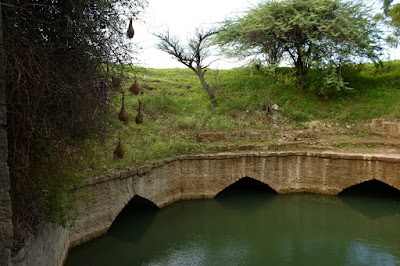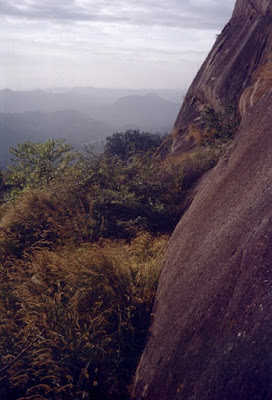Dharwad city is situated on the border line where Malnad meets Bayaluseeme i.e. hilly terrain of Western Ghats and the black-soil plains. Dharwad has an interesting history going back 900 years. Below are few pictures (caption in clockwise) and a list of places to see in Dharwad district.
 |
| Ficus Krishnae tree, Amargol Banashankari temple, Dharwad fort gateway, Ulavi Basaveshwara temple. |
 |
| Someshwara temple, Basel Mission church, Sadan Kari, Tapovan |
 |
| Siddarooda Matha, Unkal Chandramouleshwara temple, Kundagol Shambulingeshwara temple, Teachers Training College |
 |
| Muruga Matha, Thakur pedha box, Amminabavi cave temple, Regional Science Center |
- Babusingh Thakur Pedha shop - the iconic sweet maker of Dharwad established in the XIX Century. Happy events are marked with the presence of pedhas.
- Basel Mission Church - Probably the oldest church in Dharwad was established in 1836.
- Bendre Bhavan - A memorial to Jnanapith awardee Shri Dattatraya Ramachandra Bendre (Da Ra Bendre) one of the foremost poets of Karnataka and India. Bendre Bhavan is situated just across Sadankeri.
- Botanical Garden of Karnataka University is a home to rare plant species. One of the main attractions is Krishnae Ficus trees and pine cone trees. This is also home to variety of birds and insects.
- Collection of ancient sculptures at Police Headquarters campus, opposite residential school.
- Dattatreya Gudi - a temple built during British times in Maratha architecture. Da Ra Bendre was a regular visitor to this temple. Within the temple premises is a Samskrutha Shale (Sanskrit school).
- Dharwad Regional Science Center, KUD - a museum which makes learning enjoyable, wonderful place to spend quality time for children and grownups alike.
- Kargil Stupa - A memorial to Indian army soldiers from North Karnataka who were killed at Kargil. The memorial is located just across District Collector's office.
- Karnataka College Dharwad - this iconic red colored building was constructed during the pre-independence times, it was meant to house Indian Railways offices. The railway office was shifted to Hubli for better feasibility and the building was used as army barracks before converting it into a college.
- Karnataka University Dharwad - Established in 1950, KUD is the one of oldest universities of India. Within the campus are several interesting places; the Botanical Garden, History and Geology museums.
- Kelageri Kere - is the biggest lake of Dharwad with 100+ year history. Migratory water birds camp at Kelgeri lake between November and April. Early morning is the best time to see them feeding.
- Shirdi Sai Baba temple off Kelageri road. This is the biggest Sai temple in Dharwad city.
- Kittur Chennamma Park - named in memory of the warrior queen of Kittur who fought against the British army to retain freedom of her late husband's kingdom. Within the park is a memorial to John Thackeray the British collector who was slain by Chennamma during the rebellion at Kittur.
- Muruga Matta - a Lingayath monastery with a long history. The Matha supports school and college going boys from simple surrounding villages by providing them boarding & lodging within the monastery campus.
- Nuggikeri Hanuman Mandir - Nuggikeri lake is situated in a valley on the city outskirts off Dharwad-Kalghatgi road. On the lake bank is an ancient temple dedicated to Lord Hanuman. The lake creates a relaxing atmosphere during sunset. This popular temple attracts hundreds of people on Saturdays and festival days.
- Prashantadhama ~ Durgadevi temple - a temple complex situated within the police headquarters campus right next to Sadankeri.
- Ramakrishna Ashram - the Dharwad chapter of Ramakrishna Mission is situated at Channabasaveshwara Nagar.
- Remains of Dharwad fort - two gateways with ancient wooden doors is what's remaining of the fort.
- Sadhankeri - this little pond is known for its landscaped gardens, boating and musical fountain. The garden is open from dawn to 8 PM. Musical fountain show happens on Saturdays, Sundays and government holidays.
- Sanjeevini Park - is a hill garden created by Karnataka Forest Department about 8 kms on Dharwad-Hubli road.
- Someshawara Gudi - This XII century temple dedicated to Lord Shiva has a peaceful ambiance. The 2½' tall black stone sculpture of Basavanna (Nandi) is a beauty not to be missed.
- Shalmala Ugamasthala - About half a kilometer from Someswara Gudi is the birth place of river Shalmala. Though Shalmala begins here, the stream goes underground within a hundred meters, i.e. Shalmala is a Guptagamini and surfaces somewhere in the jungles of western ghats. On its banks are historical places such as Shasralinga and Sonda fort.
- Tapovan - This is the ashram established by Shri. Kumaraswamiji- a yogi, a philosopher, a humanist, a writer and a social reformer. The ashram's gardens creates a peaceful ambiance.
- Teachers Training Institute - constructed during the pre-independence times, the group of red buildings was meant to house Indian Railways offices. The main building's twin tower is an architectural beauty.
- Ulavi Basaveshwara Gudi - this temple dedicated to Lord Shiva is situated on a hillock, is probably the highest point of Dharwad. The temple is small but has lot of open space and greenery around it.
- University of Agricultural Sciences - Established in 1986 USA, Dharwad is a major center for agricultural research & education.
- Cave temple of Amminabaavi - Amminabavi is a village off Dharwad-Saundatti road known for its large well and Jain Basti. On the village outskirts, over a wide mound is a graveyard within which is a man-made cave temple. The cave was hacked single handed by an ascetic living in the graveyard.
- Paarshvanaath Basti, Amminabhavi - This is one of the historic Jain Bastis in Dharwad district. The deity is ancient and there's a small collection of ancient stone sculptures.
- Neera Sagar - is the large man-made lake about 20 km off Dharwad-Kalghatgi road. The check dam here impounds Bedthi Halla creating a nice reservoir. Water from this lake is supplied to Hubli city and also used for agricultural purpose.
- Banashankari Devasthana, Amargol - this XII century temple built during Kalyana Chalukyan rule is situated in the village of Amargol about 12 km on Dharwad-Hubli road.
- Sri Chandramouleshwara Devasthana, Unkal - this XII century temple built during Chalukyan rule is situated in Unkal village, one of the villages merged into Hubli city. In this temple, one of the deities is Chaturmukha Linga, a rare form of Shivalinga.
- Mini Lalbagh - a public garden with a glass house similar to Bangalore's Lalbagh.
- Nrupatunga Betta - Hubli is one city which has a lake and a hillock. Like Unkal lake and village, Nrupatunga hill gradually merged into the fast growing Hubli city. The hillock is situated on north-west side of Hubli city. Its a popular place for morning walks.
- Shirdi Sai Baba temples, Hubballi - Hubli city has two temples dedicated to Shirdi Sai Baba. While one is opposite Idgah Maidan near Kitturu Chennamma circle, the other temple is on the slopes of Nrupatunga Betta.
- Unkal Kere - As you approach Hubli from Dharwad side, you pass by Unkal lake. At the lake center is a statue of Swami Vivekananda and on its shore is a public garden. Boating is a popular form of entertainment here.
- Ulavi Channabasaveshwara temple, Unkal - a temple dedicated to Channabasaveshwara, nephew of Jagadguru Basaveshwara. This ancient temple is situated on the Unkal lake shore, when the lake fills to its brim, the water level reaches the temple floor.
- Mooru Savira Mata - This is a Lingayath monastery said to be established in XII Century by Jagadguru Basaveshwara's nephew Channabasaveshwara. After escaping from Kalyana, a group of Shivasharanas led by Channabasaveshwara camped here, established this Matha and moved into the jungles of Ulavi.
- Siddharooda Mata - this Lingayath monastery was established by Shri Siddharudha Swami who lived between March 1836 and August 1929. His mortal remains are enshrined here. This is a popular religious place for people of North Karnataka.
- Sri Bhavani Shankar & Narayana Devastana, Old Hubballi - A Trikutachala Devastana built during the Chalukyan times. This temple has stood the test of time, its in a good condition. Rituals are performed everyday and open to public.
- Railway Museum - Inaugurated in Aug 2020, this is the second railway museum in Karnataka. The museum is a collection of railway artifacts and a toy train. The museum is situated on Hubballi-Gadag highway, about a kilometer from the railway underpass.
- Navagraha Theertha, Varur - this is a Jain shrine dedicated to nine cosmic bodies. At this center is a 61' statue of Bhagavan Parshwanath and statues of eight other Tirthankara.
- Adargunchi Doddappa and Budarsinghi Hanumappa temples - unique temples with ancient idols of Adargunchi and Budarsinghi villages off Hubli-Bangalore national highway. The villages are about 10 km from Hubli,
- Sri Shambulingesvara Devasthana, Kundgol - a Chalukyan temple dedicated to Lord Shiva. The temple is known for its turned and mirror polished pillars.
- Basavanna Devastana, Tambur - This is a beautiful temple dedicated to Basavanna built during Chalukyan times. The temple is situated at Tamboor village in Devikoppa forests close to Kalghatgi town. Also close to the village is a waterbody names Tamboor Kere.
- Sri Madiwaleshwara Matha, Garag - a Lingayath monastery established by Sri Madiwaleshwara a contemporary of Kittur Chennamma, Sishunala Sharief, Siddaroodaswami and Nagalingaswami of Navalgund. He was found as an infant in a banana plantation near Kittur and adopted by Mallasarja Desai and Chennamma. On attaining teenage he leaves home and enters monkhood. He is said to have traveled to Nepal two times, stayed at Nepal king's palace as a guest. Finally he establishes a monastery on a piece of land donated by Hangarki Desai. The monastery is situated next to Tuprihalla which flows between Hangarki and Garag.
- Khadi Gramudyoga Kendra, Garag - this is one of the two centers in India where fabric for the Indian national flag is officially produced. Garag is about 18 km northwest of Dharwad.
- Jain Basadi, Garag - the Jain temple's history goes back several centuries, probably to Chalukyan times.
- Veerabhadreshwara Gudi, Tadakod - is a temple dedicated to Lord Shiva, probably built 600 years ago. Tadkod is a small village about 5 kms from Garag.
- Rangathaswami Gudi, Devarahubballi - an ancient shrine dedicated to Lord Rangantha. The idol, a beautiful stone sculpture seems 500 to 600 years old.
- Amruteshwara Devasthana, Annigeri - Amruteshwara temple was built in the XI Century CE by Kalyani Chalukyan rulers. The temple built of soapstone has 76 pillars, and its walls are covered with sculptures of characters from Hindu legends. It is said that Amruteshwara temple was to be the prototype for Mahadeva temple of Itagi village in Koppal district. Besides, Amruteshwara, there are six other ancient temples in Annigeri which could be of interest to tourists.
- Ajata Nagalingaswami Mata, Navalgund - a Lingayath Matha popular for its mysterious book. A hole runs through the pages of the book, which is gradually closing year after year. The book is kept for public display once a month.
- Sri Kalmeshwara Gudi, Kamadhenu - this is a temple with its history going back to Chalukyan times which means it is about 800 to 900 years old.































































